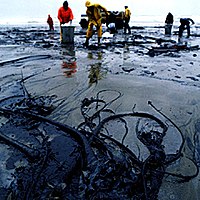
Photo from wikipedia
A local oil spill is the main cause of hydrocarbon soil pollution. Biological treatment of oil polluted soil may be possible due to the presence of oil-utilizing microorganisms at the… Click to show full abstract
A local oil spill is the main cause of hydrocarbon soil pollution. Biological treatment of oil polluted soil may be possible due to the presence of oil-utilizing microorganisms at the site. Several factors affecting soil oil degradation include hydrocarbons solubility, soil texture, ventilation, oil toxicity, availability of nutrients, etc. Many techniques are used in the bioremediation of oil polluted soil. In this study, the compost system was used to increase the oxygen transmission with the addition of nutrients (NPK), hay (bulking agent) and biosurfactants producing bacteria (B. cereus WR146) to enhance the hydrocarbons degradation in agricultural soil. After 3 months of biological treatment, crude oil content decreased to3.73-2.42% from the initial 4.20%. The percentage of crude oil degradation ranged from 20.1-44.5 depending on the treatment method used. Carbon dioxide development rates ranged from 30.655.0 μg g day, indicating a significant crude oil degradation due to aerobic microorganisms. There is no clear picture of whether nutrients and bulking agent increase the crude oil degradation rates in the current study. The results indicate that the bioremediation of soil polluted with crude oil is more efficient when using compost system, good ventilation, nutrients, and biosurfactants producing bacteria.
Journal Title: Applied Ecology and Environmental Research
Year Published: 2020
Link to full text (if available)
Share on Social Media: Sign Up to like & get
recommendations!